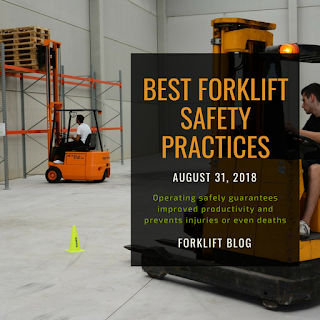BEST FORKLIFT SAFETY PRACTICES
Best forklift safety practice can help any business optimize forklift security in their workplace based on their distinctive program of safety that they function within. A facility which works cushion tire, electric forklifts inside has a set of variables from a company that operates diesel forklifts, with pneumatic tires, outdoors on substrates which vary.There are, though, a couple things that can span the diverse operating parameters and may apply to almost any material and forklift handling performance. Here we list a couple of things are considered"best practices" with respect to making and keeping a safe forklift operating environment.
Safe Operating Practices
- Do not operate a forklift unless you have received thorough forklift operator instruction.
- Training must include not understanding forklifts function, their limitations and risks, but are also special to your center and specific regarding the equipment you function.
- Use seat belts. If not installed, retrofit old type forklifts with an operator restraint system.
- Conduct reviews in your forklifts prior to an operator puts the forklift into support.
- This means at the start of each day, or each shift change, forklifts must be inspected for damage or failing/failed elements.
- Report to your supervisor any damage or issues that happen to a forklift during your shift.
- Ensure there is a method to lock-out forklifts which have been reported and they cannot be used until repaired by an experienced technician.
Best Operating Practices
Operators use extreme caution about grades, ramps, or inclines. The operator must travel up and down. Do not attempt to turn around on ramps or grades. Loads upslope and elevated, not pointed downslope.- On grades, tilt the load back and raise it as far as needed to clear the street surface.
- Do not raise or lower the forks while the forklift is not moving.
- Don't handle loads that are heavier than the weight capacity of the pipe.
- Run the Celtics in a speed that will allow it to be stopped safely.
- Bogged down and sound the horn at cross aisles and other locations where vision is obstructed.
- Make every attempt when there is a forklift nearby to alert employees.
- Use horns, backup alarms that are audible, and flashing lights to warn operators along with employees in the area.
- Flashing lights are particularly significant in places where the ambient sound level is quite high.
- Look toward the travel path and keep a clear view of it.
- Do not allow passengers to ride forklift trucks unless a chair is supplied.
- If dismounting from a pipe, place the parking brake, lower the brakes or lifting wheels, and neutralize the controllers.
- Do not use a forklift to elevate workers who are standing on the forks.
ADDITIONAL FORKLIFT SAFETY PRACTICES
Operators should follow operator manuals, which can be provided by all gear manufacturers and describe the safe operation and maintenance of forklifts.- Separate census traffic as well as other workers where possible.
- Restrict some aisles to workers on foot just or forklifts only.
- Limit the usage of forklifts near future clocks, break rooms, cafeterias, and chief exits, particularly when the flow of workers on foot is at a peak (such as in the conclusion of a shift or during breaks).
- Install physical barriers by which functional to make sure that workstations are isolated out of walkers headed by forklifts. Do not store racks bins, or other materials at intersections corners, or other places that block the view of operators.
- Evaluate intersections and other blind corners to determine whether overhead dome mirrors may improve the visibility of forklift operators or employees on foot. Ought to have the ability to execute corrective steps.
- Enforce safe driving practices such as obeying speed limits, stopping at stop signs, and slowing down
- down and blowing the horn at intersections.
- Repair and preserve cracks, crumbling edges, along with other flaws on loading docks, aisles, and other surfaces that are operating.
- Have a thoroughly planned maintenance program set up for each of your forklifts depending upon usage and sort of obligation operation.
FORKLIFT TRAINING AND CERT AVAILABLE!
Contact us at 888 501-1355 or please visit our website to view class schedules and dates. Let us help you get started or recertified today.

Comments
Post a Comment